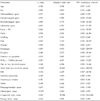1. Colmenero Ruiz C, Labajo AD, Yanez Vilas I, Paniagua J. Thoracic complications of deeply situated serous neck infections. J Craniomaxillofac Surg. 1993. 21:76–81.

2. Beck HJ, Salassa JR, McCaffrey TV, Hermans PE. Life-threatening soft-tissue infections of the neck. Laryngoscope. 1984. 94:354–362.

3. Chen MK, Wen YS, Hsiao HC. Thoracic complications of deep-neck infection-report of four cases. J Otolaryngol Soc Taiwan. 1997. 32:454–458.
4. Estrera AS, Landay MJ, Grisham JM, Sinn DP, Platt MR. Descending necrotizing mediastinitis. Surg Gynecol Obstet. 1983. 157:545–552.
5. Levine TM, Wurster CF, Krespi YP. Mediastinitis occurring as a complication of odontogenic infections. Laryngoscope. 1986. 96:747–750.

6. Wang LF, Kuo WR, Tsai SM, Huang KJ. Characterizations of life-threatening deep cervical space infections: a review of one hundred ninety-six cases. Am J Otolaryngol. 2003. 24:111–117.

7. Parhiscar A, Har-El G. Deep neck abscess: a retrospective review of 210 cases. Ann Otol Rhinol Laryngol. 2001. 110:1051–1054.

8. Bottin R, Marioni G, Rinaldi R, Boninsegna M, Salvadori L, Staffieri A. Deep neck infection: a present-day complication. A retrospective review of 83 cases (1998-2001). Eur Arch Otorhinolaryngol. 2003. 260:576–579.

9. Huang TT, Liu TC, Chen PR, Tseng FY, Yeh TH, Chen YS. Deep neck infection: analysis of 185 cases. Head Neck. 2004. 26:854–860.

10. Nagy M, Pizzuto M, Backstrom J, Brodsky L. Deep neck infections in children: a new approach to diagnosis and treatment. Laryngoscope. 1997. 107:1627–1634.

11. Marra S, Hotaling AJ. Deep neck infections. Am J Otolaryngol. 1996. 17:287–298.

12. Scott BA, Stiernberg CM, Driscoll BP. Bailey BJ, editor. Infections of the deep spaces of the neck. Head and Neck Surgery-Otolaryngology. 2001. 3rd ed. Philadelphia: JB Lippincott;701–715.
13. Plaza Mayor G, Martinez-San Millan J, Martinez-Vidal A. Is conservative treatment of deep neck space infections appropriate. Head Neck. 2001. 23:126–133.

14. Mihos P, Potaris K, Gakidis I, Papadakis D, Rallis G. Management of descending necrotizing mediastinitis. J Oral Maxillofac Surg. 2004. 62:966–972.

15. Infante Cossio P, Gonzalez Padilla JD, Garcia Peria A, Salazar Fernandez CI, Rollon Mayordomo A. Acute mediastinitis with fatal outcome secondary to odontogenic infection. Rev Actual Odontoestomatol Esp. 1991. 51:51–54.
16. Gratz KW, Schotland C, Prein J. Case report of concomitant mediastinitis due to an odontogenic abscess. Schweiz Monatsschr Zahnmed. 1986. 96:588–593.
17. Umeda M, Minamikawa T, Komatsubara H, Shibuya Y, Yokoo S, Komori T. Necrotizing fasciitis caused by dental infection: a retrospective analysis of 9 cases and a review of the literature. Oral Surg Oral Med Oral Pathol Oral Radiol Endod. 2003. 95:283–290.

18. Ashar A. Odontogenic cervical necrotizing fasciitis. J Coll Physicians Surg Pak. 2004. 14:119–121.
19. Rapoport Y, Himelfarb MZ, Zikk D, Bloom J. Cervical necrotizing fasciitis of odontogenic origin. Oral Surg Oral Med Oral Pathol. 1991. 72:15–18.

20. McAndrew PG, Davies SJ, Griffiths RW. Necrotising fasciitis caused by dental infection. Br J Oral Maxillofac Surg. 1987. 25:314–322.

21. Tom MB, Rice DH. Presentation and management of neck abscess: a retrospective analysis. Laryngoscope. 1988. 98:877–880.
22. Stiernberg CM. Deep-neck space infections. Diagnosis and management. Arch Otolaryngol Head Neck Surg. 1986. 112:1274–1279.

23. Har-El G, Aroesty JH, Shaha A, Lucente FE. Changing trends in deep neck abscess. A retrospective study of 110 patients. Oral Surg Oral Med Oral Pathol. 1994. 77:446–450.
24. Bartlett JG, Gorbach SL. Anaerobic infections of the head and neck. Otolaryngol Clin North Am. 1976. 9:655–678.

25. Sonnenwirth AC. Davis D, Dulbecco R, Eisen N, editors. The enteric bacilli and bacteroides. Microbiology. 1981. 3rd ed. New York: Harper & Row;659–660.
26. Leibovici L, Yehezkelli Y, Porter A, Regev A, Krauze I, Harell D. Influence of diabetes mellitus and glycaemic control on the characteristics and outcome of common infections. Diabet Med. 1996. 13:457–463.

27. Chen MK, Wen YS, Chang CC, Huang MT, Hsiao HC. Predisposing factors of life-threatening deep neck infection: logistic regression analysis of 214 cases. J Otolaryngol. 1998. 27:141–144.
28. Kiernan PD, Hernandez A, Byrne WD, Bloom R, Dicicco B, Hetrick V, et al. Descending cervical mediastinitis. Ann Thorac Surg. 1998. 65:1483–1488.

29. Barratt GE, Koopmann CF Jr, Coulthard SW. Retropharyngeal abscess-a ten-year experience. Laryngoscope. 1984. 94:455–463.





 PDF
PDF ePub
ePub Citation
Citation Print
Print






 XML Download
XML Download